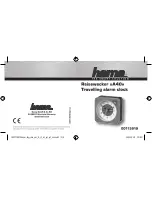
Chapter 1 Overview of the TimeProvider
Overview
22
TimeProvider User’s Guide
097-58001-02 Revision G – April 2008
Figure 1-3.
TimeProvider 1100 Expansion Panel
Inputs
The TimeProvider accepts the following types of input signals:
Primary Reference Signals (PRS): 1.544 MHz, 2.048 MHz, 5 MHz, 6.312 MHz, or
10 MHz
Span input signals:
– E1 or 2.048 MHz analog; user-selectable CAS or CCS framing
– T1 D4, Extended Superframe (ESF)
– 1.544 and 6.312 MHz
– Composite Clock, including Japan Composite Clock (JCC) and Japan
Composite Clock with 400 Hz (JCC4) signals
GPS input:
– GPS signal from the stand-alone TimeProvider Interface Unit (TPIU)
– GPS signal into the TPIU integrated with the IMC (IMC/TPIU card)
The TimeProvider qualifies the input reference signals and detects the following
errors: Loss of Signal (LOS), Alarm Indication Signal (AIS), Loss of Framing, and
Synchronization Status Messages (SSM) where applicable.
Reference Input
Signals
, on page 34, describes the inputs in more detail.
Outputs
The TimeProvider produces a variety of outputs to meet different signal standards.
Output signal types include 8 kHz, 1.544 MHz, 2.048 MHz, 6.312 MHz, E1, T1, CC,
JCC, JCC4, and TIA/EIA-B-422 (1.544 and 2.048 MHz). The E1 and T1 signals can
be provisioned with standard framing that meets G.703 formats. The SSM bit
location is user-selectable on E1 outputs; CRC4 must be enabled in order to provide
output SSMs. These outputs are available through one of several different
connector panels. See
Output Signals
, on page 39, for more information on output
signals.
















































